
World War I and The Art of War: Posters from the Collection of Oscar Jacobson
Artists and Posters
Oscar Brousse Jacobson (1882–1966)
Oscar Brousse Jacobson was born on May 16, 1882, in Westervik, Kalmar Lan, Sweden. He emigrated to Lindsborg, Kansas, in 1890 and studied at Bethany College, receiving a bachelor's degree in 1908. He continued his studies at the Louvre in Paris, in Sweden, and in Denmark. In 1916 he received a master of fine arts degree at Yale University and in 1941 a doctorate of fine arts from Bethany College in Lindsborg. He worked as director of the School of Art at the University of Oklahoma (OU) from 1915 until 1954. He and his wife, Jeanne d'Ucel, had three children: Yvonne, Oscar Jr., and Yolanda.
Jacobson's name is synonymous with early-twentieth-century art in Oklahoma. Educated in Europe and America, he tirelessly promoted the arts in the young state. One genre, traditional Plains Indian art, is now inexorably bound to him and to the University of Oklahoma. Because Jacobson held Indian people in high regard and treated them with respect, he became their champion and mentor. In the late 1920s he and Professor Edith Mahier, also of the OU art school, worked with a small group of five Kiowa men and briefly with one Kiowa woman. These artists and their style became world famous and have always been associated with Oscar B. Jacobson. In addition, he founded the Association of Oklahoma Artists and formally advised the Works Progress Administration's Federal Art Project for Oklahoma in the 1930s.
A prolific painter of Southwestern landscapes, Jacobson exhibited his work throughout the United States and Europe. He won numerous awards, including a Gold Medal at the 1931 Mid-Western Exhibition at the Kansas City Art Institute Invitational. He was made an honorary chief of the Kiowa tribe and was inducted into the Oklahoma Hall of Fame in 1949. He lectured at the Metropolitan Museum of Art in New York, at the Chicago Art Institute, and at more than fifty universities and colleges. His works are held by the Woolaroc Museum at Bartlesville, Oklahoma, the Jacobson Gallery in Norman, the Oklahoma City Museum of Art, and the Fred Jones Jr. Museum of Art in Norman. On September 15, 1966, he died in Norman.
Gordon Grant (1875–1962)

Will You Supply Eyes for the Navy?, Gordon Grant (courtesy of the Library of Congress).29
Gordon Grant was born in San Francisco, California, in 1875. He was educated at the Fife Academy in Scotland and at the Heatherly & Lamberth Art School in London. After completing his formal art training in 1896, Grant began working as an illustrator for the Examiner and the Chronicle in San Francisco. In 1899, Grant started working for Harper's Weekly as an artist/correspondent covering the Boer War in South Africa. From 1901 to 1909 he worked as an illustrator for Puck Magazine in New York City. At age thirty-two Grant enlisted in the 7th New York National Guard for service during the Punitive Expedition against Mexico in 1916. Upon the entry of the United States into World War I in 1917, the Army stationed Grant in Washington DC with the rank of captain. After the Armistice in 1918, Grant continued to work as an illustrator and painted oil and watercolor paintings of marine subjects. His painting of the ship Old Ironsides hangs in the White House.
During World War I, manufacturing could not keep up with the US Navy and Merchant Marine demand for binoculars. The shortage of these instruments prompted a request to the American public from the Department of the Navy for binoculars, spyglasses, telescopes, sextants, and chronometers. The government asked the public to send these instruments to the Secretary of the Navy. Upon passing inspection of the scientific instruments, the Navy would send a letter of thanks to the donor, a check for $1 rental, and the promise that the loaned item would return at the end of the war.
James A. Daugherty (1889–1974)
James H. Daugherty was born in Ashville, North Carolina, in 1889. Daugherty studied art at the Corcoran School of Art. After completing his formal education Daugherty was commissioned to produce posters for various government agencies. Daugherty was one of the first American artists to print abstract and near abstract compositions based upon the power of color relationships. During the Great Depression, Daugherty painted murals for the WPA from 1934 to 1939. In 1940, Daugherty received the John Newbery Medal for illustrating a children's book on Daniel Boone.

The Ships are Coming, James A. Daugherty (image courtesy of the Library of Congress).30
The United States Congress created the Emergency Fleet Corporation in 1917 to establish, construct, and manage a fleet of ships to aid in defense shipping and overseas commerce. The Emergency Fleet Corporation produced both steel and wooden ships from hundreds of shipyards on both the east and west coasts. This fleet transported American fighting forces to France and supplied both the Allied armies but also the people of France, England, and Belgium.
William Henry "Haskell" Coffin (1878–1941)
Haskell Coffin was born in Charleston, South Carolina, in 1878. He studied art at the Corcoran School of Art. After completing his formal education he painted society portraits of the leading families of Charleston. In 1902 he traveled to France to train informally with artists there. Coffin specialized in images of women and produced cover art for The Saturday Evening Post, The American Magazine, Redbook, McCall's, Leslie's Illustrated, and the Pictorial Review. Coffin committed suicide in 1941.
The United States incurred a large amount of debt in fighting World War I. To offset that cost, the Treasury Department issued Liberty Bonds and War Savings Stamps. Average citizens purchased the lower cost stamps for as little as ten cents with the intention to accumulate the stamps to equal a $5 War Savings Certificate. Purchasers could redeem the Certificate for Liberty Bonds. Americans could purchase a stamp for $4.12, which would pay $5 upon maturity. The stamps and certificates reached full maturity in 1926.

Joan of Arc Saved France, Haskell Coffin (image courtesy of the Library of Congress).31

Over the Top For You, Sidney Reisenberg (image courtesy of the Library of Congress).32
Sidney H. Reisenberg (1885–1971)
Sidney Reisenberg was born in Chicago, Illinois, in 1885. He studied art at the Art Institute of Chicago. In 1905 after completing his formal education, Reisenberg worked as a curator at the Hudson River Museum of Art. He later taught art at the Westchester Arts Association. His first illustration appeared in People's Home in 1912. Reisenberg also worked for The Saturday Evening Post, Harper's Weekly, and Boy's Life. After the Armistice, Reisenberg continued to work as an illustrator for pulp magazines.
"Over the Top" was phrase used during the war to describe the fundamental activity of trench warfare. Soldiers would have to climb out of their defensive trenches and "over the top" of the parapets to mount an offensive attack. As the casualties of the war grew in number, the term more and more came to describe the excessive, foolhardy actions that created the senseless waste of life associated with World War I and trench warfare. Shortly after the end of the war, the term came to symbolize its current meaning and use of excessive action.
John A. Coughlin (1885–1943)
John A. Coughlin was born in Chicago, Illinois, in 1885. He studied art at Notre Dame beginning in 1900. After finishing at Notre Dame, Coughlin studied art under the guidance of Jobson Emilien Paradis. Further studies also included time at the Art Institute of Chicago. By 1912, Coughlin had his own studio in New York City. Within a year he was painting covers for various magazines. For the next twenty years he built a career by painted pulp magazine covers. In fact, his cover for a 1931 issue of Detective Story Magazine is the first appearance of the The Shadow.

Go Over the Top/US Marines, John Coughlin (image courtesy of the Library of Congress).33
The United States Marine Corps served in France assigned to the army's 2nd Infantry Division. In the early summer of 1918, the German army began an offensive designed to win the war before American troops deployed thoroughly across the front lines. This offensive punched a hole through French trenches and came within fifty-five miles of Paris. The 4th Marine Brigade and the 7th Infantry Regiment stopped the petering German drive at Belleau Wood, a forest near Belleau, France. The battle to push back the German troops in Belleau Wood began with the first American offensive of WWI on June 6, 1918. The battle continued for three more weeks, resulting in 10,000 American casualties, and witnessed the creation of the German nickname for the Marines of Teufel Hunden or "Devil Dogs."
Henry Raleigh (1880–1945)
Henry Raleigh was born in Portland, Oregon, in 1880. He dropped out of art school when he was twelve years old and began working on the docks. There his natural talent impressed his boss who subsequently paid for Raleigh to attend the Hopkin's Academy in San Francisco. After graduating, Raleigh began working as an illustrator for the San Francisco Bulletin. He later worked for Vanity Fair, Harper's Bazaar, Collier's, and The Saturday Evening Post. Raleigh is perhaps the most prolific illustrator of this time period. Government agencies created 5 million copies of his WWI poster titled Hunger. For most of his career as an illustrator, Raleigh earned enough income that he only worked four months of a year and often gave away thousands of dollars. As tastes in illustrations changed, Raleigh found it harder and harder to earn a living. In 1945, he committed suicide by jumping from a high rise building in New York City.
The name 'hun' is a reference to the fourth-century tribes comprising an empire under Attilla. These nomadic people marked the end of the Roman Empire and often described as warlike. Drawing a connection between the huns and the soldiers of the German Empire served to demonize the enemy and increase recruitment in the United States.
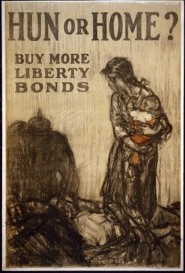
Hun or Home?, Henry Raleigh (image courtesy of the Library of Congress).34

Blood or Bread, Henry Raleigh (image courtesy of the Library of Congress).35
Food rationing in the United States began in August of 1917 shortly after the declaration of war. The government created the United States Food Administration to manage the supply, conservation, distribution, and transportation of food. Not only did the United States supply troops in France, but also the civilian populations of Allied European nations. Posters created by the agency implored Americans to reduce their food consumption, ration available supplies, and to change their diets to more fruits and vegetables, which were too difficult to transport overseas. This rationing and supply program continued past the Armistice and garnered its director, Herbert Hoover, the nickname of "The Great Humanitarian."
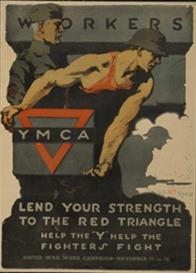
Workers Lend Your Strength, Adrian Gil Spear (image courtesy of the Library of Congress).36
Adrian Gil Spear (1885–1965)
Adrian Gil Spear was born on August 11, 1885, in Camden, New Jersey. Information on his formal art training is unknown. By 1915, Spear wrote the script of the motion picture Poet and Peasant for the Lubin Manufacturing Company. He went on to write or contribute to scripts for fifteen more motion pictures as an employee for the Famous Players Lasky, an early movie production company. Additionally he created the artwork for several, if not all, of these films.
James Montgomery Flagg (1877–1960)
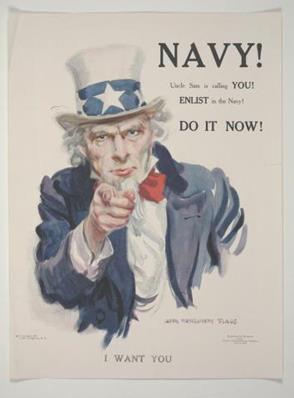
Do It Now!, James Montgomery Flagg (image courtesy of the Dallas Museum of Art).37
James Montgomery Flagg was born in Pelham Manor, New York, in 1877. By the age of fourteen he was a contributing artist for Life and Lodge magazines. He studied art at the Art Students League of New York and fine art in London and Paris for two additional years. Flagg created his most famous work for the July 1916 issue of Leslie's Magazine to encourage enlistment in the US Army. He was inspired by a slightly older British recruiting poster featuring Lord Kitschener in the same fashion as Uncle Sam. Over 4 million copies of this poster were produced during World War I. Flagg may have used his own face as the model for Uncle Sam. Before the Armistice, Flagg produced forty-six posters for the war effort.
During the War of 1812 Sam Wilson, Revolutionary War veteran and meatpacker in Troy, New York, supplied barrels of salt beef and salt pork to army contractor Elbert Anderson for local United States troops. As well as supplying meat, Sam Wilson also served as a meat inspector for the army. Wilson marked barrels passing his inspection with "E.A.-U.S.," the E.A. representing Elbert Anderson and the U.S. representing United States.
Troops from the area familiar with Sam Wilson assumed that the barrels stamped "U.S." stood for Uncle Sam. It was from this assumption that the character Uncle Sam arose.
Maginal Wright Enright Barney (1877–1966)
Born Margaret Ellen Wright in Weymouth, Massachusetts, in 1877, she went by the nickname, Maginal, created by her mother and combining her first two names. She is the younger sister to noted architect Frank Lloyd Wright. Barney attended the Chicago Arts Institute and became a commercial artist for Barnes, Crosby, and Company in Chicago. Barney illustrated sixty-three children's books during her lifetime, an occupation shared with her husband. The art style of husband and wife are very similar. Among her more notable illustration work was for books by L. Frank Baum, the author of The Wizard of Oz. Barney also worked as an illustrator for McClure's and Ladies Home Journal.
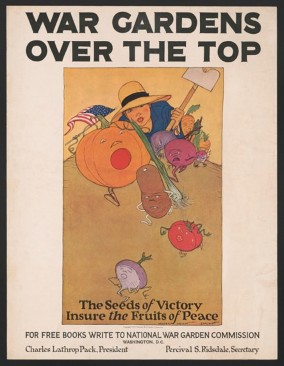
War Gardens Over The Top, Maginal Wright Enright Barney (image courtesy of the Library of Congress.)38
Charles Lathrop Pack, one of the five wealthiest men in the United States, began the National War Garden Commission in March 1917. Witnessing the massive food shortages around the world from the impact of war-induced labor shortages, loss of tillable land, military embargos, and crop failures, Pack sought to create an organization that would impel the civilian population to contribute their labor, land, and crops. The creation of war gardens would make no impact on land already under cultivation, the labor involved in agricultural production, time devoted to other industries, or the already overburdened transportation system, but could increase the world food supply. By the end of the war Americans constructed 5 million victory gardens and produced crops worth $1.2 billion.
Ellsworth Young (1866–1952)
Ellsworth Young was born in 1866 in Albia, Iowa. Young studied at the Art Institute of Chicago. After completing his studies, Young went on to work for the Denver Times and The Chicago Tribune as an editorial illustrator. Young painted several posters during WWI. Remember Belgium, shown here, is his most famous.
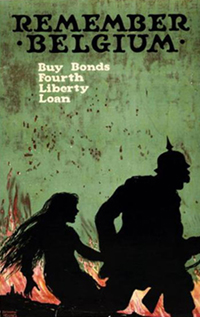
Remember Belgium, Ellsworth Young (image courtesy of the Library of Congress).39
The phrase "Remember Belgium" references the initial German attacks on France through neutral Belgium. The major powers of Europe guaranteed Belgium's independence and neutrality in an 1830 treaty between The Netherlands and Belgium. In 1914, German plans to attack the French Army included an offensive drive through Belgium and into France, in order to trap the French Army along the nation's eastern border. During this offensive, the fear of Belgian saboteurs and guerilla fighters motivated the German Army to commit numerous atrocities against the civilian population. This offensive and counter-insurgency resulted in the entry of the British Empire into the war against Germany and Austria. Posters and other propaganda capitalized on the "Rape of Belgium" as the cause for World War I, rather than the assassination of the Austrian noble Archduke Franz Ferdinand.
Dan Smith (1865–1934)
Dan Smith was born in Ivigtut, Greenland, in 1865. Smith migrated to the United States as a child with his parents. After studying art in the US, Smith traveled to Copenhagen, Denmark, at age fourteen to study at the Public Arts Institute. Upon returning to the United States, he began studies at the Philadelphia Academy of Fine Arts. In 1890, Smith became an illustrator for Frank Leslie's Illustrated Weekly. One of his first assignments depicted the massacre at Wounded Knee, South Dakota. Toward the end of that decade, Smith worked for William Randolph Hearst as an illustrator of the Spanish-American War. For the next twenty years he created cover art for the The World and continued his work as a book illustrator.
Outgoing President Taft created the United States Employment Service and the Department of Labor in 1913. This was to give organized labor a voice in a cabinet level department of the federal government. Throughout World War I, the Department of Labor worked to ensure that wages, hours, and condi- tions promoted war productivity. The Depart- ment standardized the eight-hour workday and overtime pay for employees. After the Armi- stice, the Department of Labor focused on placing veterans back into the workforce by asking businesses to register their personnel needs with them as a centralized employment service.
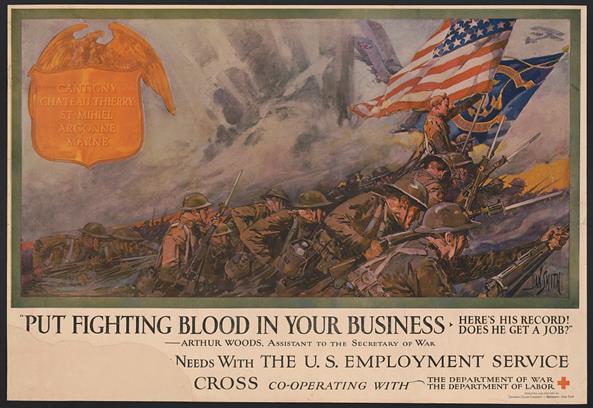
Put Fighting Blood in Your Business, Dan Smith (image courtesy of the Library of Congress).1
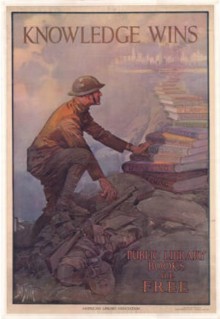
Knowldge Wins, Dan Smith (image courtesy of the State Archives of North Carolina).40
Created in 1917 by the American Library Association, the Library War Service was one of seven organizations focused on making military posts more like home. Between 1917 and 1920, the Library War Service raised $5 million and created thirty-six working libraries at military posts. During the war, these libraries provided books in braille to wounded servicemen. While the focus was to create a home environment for soldiers to enjoy, before the end of the war the libraries increasingly provided technical manuals and textbooks for vocational training.
Unknown Artist
World War I for the United States lasted one year, seven months, and five days. During that time, the armed forces had 320,518 casualties. Those killed in and out of combat, wounded, and missing, comprise this total casualty figure. Of that number 116,516 men were killed, (53,402 from direct combat), 204,002 men were wounded in action, and 3,350 men are listed as missing in action. The Spanish Flu killed 35,000 men as it spread both in the trenches of France and military installations in the United States.
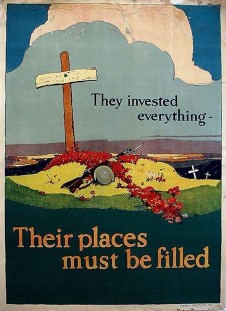
They Invested Everything, unknown (Image courtesy of Digital History).41
Men from Oklahoma filled the 36th, 42nd, and 90th Infantry Divisions. Those soldiers participated in four major operations or offensives in France. The 42nd Division participated in the Champagne-Marne Operation from July 15 to July 18, 1918, and experienced 7,317 casualties in those four days. At that rate, combat action killed or wounded seventy-six men every hour. That division transitioned directly into the Aisne-Marne Operation, which took place from July 18 to August 6, 1918. That operation took an additional 38,490 casualties in nineteen days, or eighty-four men every hour. The United States I Corps, which contained all three divisions, participated in the St. Mihiel Operation from September 12 to September 16, 1918. There were 8,600 casualties in four days. Ninety men died or received a wound every hour. In the last offensive of the war, the Meuse-Argonne Offensive, September 26 to November 11, 1918, received 110,508 casualties in forty-five days; a casualty rate of 2,456 each day or 102 every hour.
Sgt. Henry E. Clark
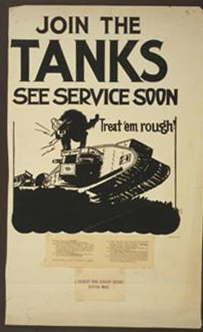
Join the Tanks, Sgt. Henry E. Clark (image courtesy of Digital History).42
Sgt. Henry E. Clark is the artist of this poster. Other than his rank, details of his life are unknown. The black cat featured on this poster and others of the period is associated with the Tank Corps of the United States Army. The stylized black cat is a cultural reference to the Hindu-German-Irish Nationalists who sabotaged the munitions depot on Black Tom Island in New York Harbor in 1916. The depot on Black Tom Island contained 1,000 tons of small arms and artillery ammunition, with another 100,000 pounds of TNT on a barge moored at the dock.
When the depot exploded, the concussion caused damage to the nearby Statue of Liberty and broke stained-glass in Manhattan. People as far away as Philadelphia and Maryland heard it. This was just one of seven acts of sabotage or manipulation by the German Empire before the entry of the United States into WWI. Among these were the sabotage of the Welland Canal on the St. Lawrence River, gun smuggling on the SS Annie Larson, arson of the Robling Wire and Cable Plant, bombing of the Vanceboro Bridge, the Great Phenol Plot, the bombing of the Mare Island Naval Shipyard, and an anthrax attack in Washington DC.. The final act was the infamous Zimmerman Note wherein the German government promised to return the southwestern United States to Mexico if the Mexican government would enter the war as an Axis ally. The Tank Corps took on the moniker "Black Toms" as the personification of revenge.

